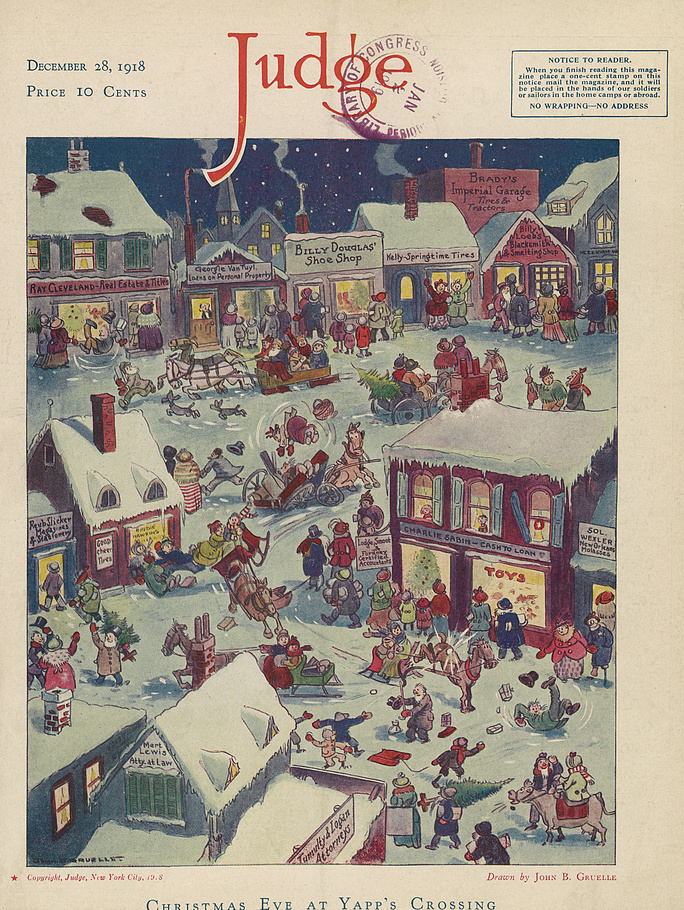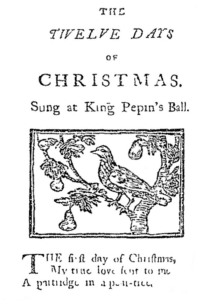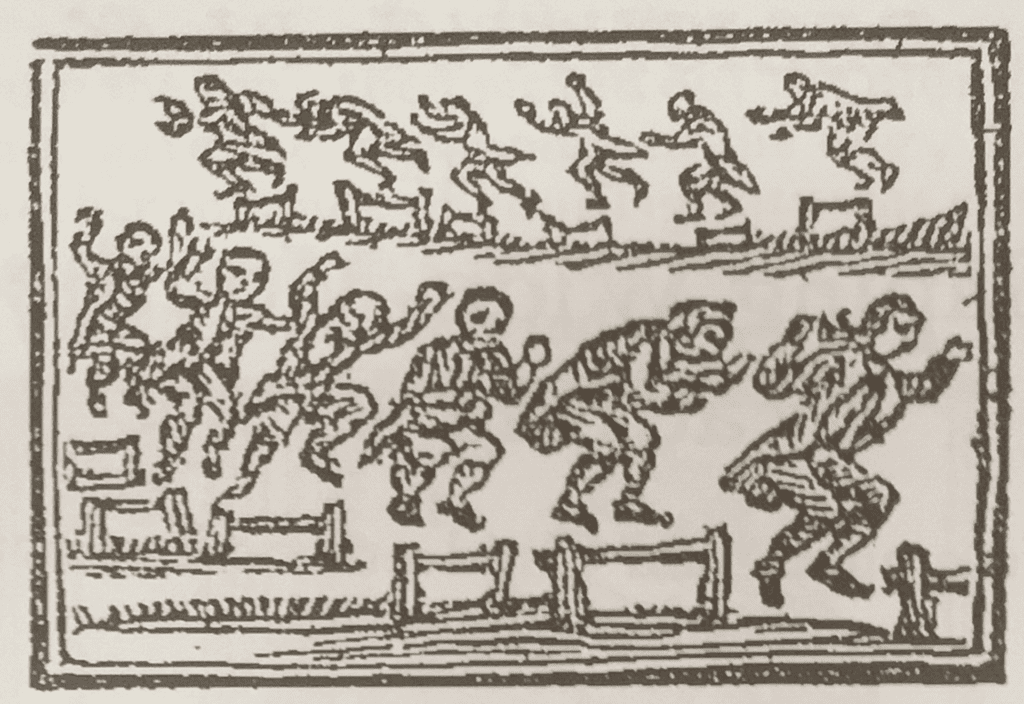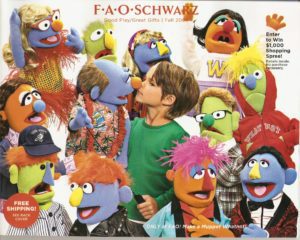While the Christmas season continues past Christmas Day into the New Year, the season pretty much ends for retailers on Christmas Eve. Immediately after Christmas, New Year’s Eve items like champagne and drinks arrive, along with sports-themed party food. In department stores, New Years outfits and champagne glasses move to prominence. Other than that, it’s discounts, returns and gift cards until the Valentine’s red arrives.
But what if the retail definition of Christmas changed, a bit, and reflected a new (but old) version of the holidays, not as discrete one-day affairs for consumers, but a diverse and varied aggregation of different holidays reflecting Twelve Days of Christmas, and its predecessor seasons Hanukkah and Advent? Today, so many Americans take off the week after Christmas, because of kids at home, family visits and December trips, why not take this into consideration.
This harkens back to early America, where Christmas was not a one-day holiday but a 12-day extravaganza, beginning with putting up the tree on Christmas Eve. Family and friends came to stay for the Twelve Days. Couples got married, and parties went for night after night in a house party, through the New Year. In this version of Christmas, which according to Christian churches is historically correct, is that Advent is the planning season up to Christmas, which begins on Christmas Eve. In this version, Advent ratchets Christmas back, and blows it up to crazy fun when the first star is seen on Christmas Eve.
The Twelve Days, known by that endlessly played song, are characterized by their numbering, according to their dates in the 12 days that lead up to Twelfth Night, and ending with Epiphany. The idea is not that the retailer needs to do a new store set for the Twelve Days, only that one needs to think of the things that people could be suggested to be sold on the days after Christmas, and try to tune into marketing them.
The reality is that people are looking for things to do in the days after Christmas. Each day below has the day of the 12 Days, with the proper and actual holidays associated with it, and regional traditions, and suggested retail items. Planograms can be tweaked, not completely changed.
General Themes of the Twelve Days Approach:
December can have three promotional thrusts. There are items sold for Advent and Hanukkah. This season includes items sold for Christmas, as well as menorahs and traditional Advent items, like Advent calendars, Advent table wreaths and elaborate creches. Today, Michael’s stocks Advent candles, which are for the four Sundays of Advent before Christmas. Elf on a Shelf is in the spirit of Advent, though parents hate having to come up with new stuff to manage each day to hide the stupid thing. Retailers continue to sell Christmas items and promote Christmas, but can emphasize planning.
In that mix are Twelve Days items for Christmas week, for each of the 12 days, and including New Year’s Day. Minor store set tweaks could de-emphasize Christmas the day after Christmas, and put up “12 Days” graphics with items. Of course all of this has many factors each year because of the calendar, including if Christmas is on a Sunday, and how many Sundays there are in December. The Twelve Days sale is already a promotional thing. Make sure, however, that Twelve Days is used ONLY in the days after Christmas, as things are busy enough up to Christmas Day.
Changing the approach is not about a wholesale change, but nuanced changes in a few promotional signs. For party planners (and exhausted families), it would mean trying to move some of your corporate holiday parties to the days AFTER Christmas and before New Year’s Eve. The U.K. does a fantastic job of holding city fun fairs. In the U.S., churches have started camps, and museums have organized fun promotions, as everyone is home.
The bank PNC takes the Twelve Days to a whole new level, as each year it has an inflation index tied to the actual cost of the Christmas items in the song. Last year, their Christmas Price Index was up 10 percent, which is pretty accurate.
It would look like this:

- Hanukkah and Advent: The heavy celebration of Hanukkah, which is pretty much an American tradition, is ingrained in retailing, but many more Christians, even evangelicals, are celebrating Advent. The blue and white of Hanukkah actually matches the blue, purple and pink of Advent candles, which are put on a wreath. Retailers should push Advent calendars, with small items in them, a practice that exploded with Lego, which sells an Advent calendar each year. Christmas items are still sold, as usual, but the store can have some signage and items. The creche and outdoor dioramas continue to have room on the sales floor.
- Christmas Eve: Busy, think of It’s a Wonderful Life. The party starts when the bank closes.
- Christmas: Looks the same. Even fruit cake.
- Twelve Days: Parents give “Twelve Days” of small gifts for kids, and kids can do the same thing, beginning at Christmas. Holidays within the days, like Christmas Day, Boxing Day, Kwanzaa, New Year’s Eve, New Year’s Day and Epiphany are all within this period. Candles are used each day. Yule logs are still possible in the man-cave fire-it. In this period, there are Sundays, which include heavy sports. Below are descriptions of each day, and retail opportunities.
The Days Explained

- Christmas Day, Dec. 25
First Day, Partridge in a Pear Tree
Retail is completely prepared for this day already. Not much more to say here, except that the messaging needs to be that Christmas “Twelve Days” of sales and new items begins the day after.
Sports Tie Ins: NBA special offerings compete with an increasingly popular NFL lineup in the U.S. - Boxing Day, St. Stephen’s Day, Kwanzaa First Day, Dec. 26
Second Day, Two Turtle Doves
Gift cards day! This was traditionally Boxing Day, the day off for servants, and eating the bounty from Christmas Day, traditionally. This is echoed in today’s retail gift card spending extravaganza. Originally, the Queen of England went horse riding followed by an annual lunch of cold cuts and salads, as the help was off. Today that means no lawn service, and gifts for those who have helped you, who are out enjoying the gift. This is often called Wren Day in old England, where a dead wren (or figurative one) would be put on a pole. There were often straw boy mummers, as well. In olden days, metal boxes were filled with coins for seagoing ships. The Root website addresses the importance of gift cards for workers in an issue in a sassy story called The Caucasian’s Guide to Black Christmas.
Sports Tie Ins: Australia Boxing Day Test, CANZUK football, horse racing and cricket.
Food Tie Ins: All leftovers and salads and cold things. Mom needs a break. In England, Kedgeree, a fish dish. Salads and bread.
Retail Tie Ins: Many companies now give gift cards to employees instead of Christmas bonuses. Decorations boxes and metal boxes. Perhaps retailers promote some regifting by promoting wrapping and boxes. - St. John the Evangelist Day, Dec. 27
Third Day, French Hens
St. John was the evangelist and wrote the book of John and Revelation, that tells the end of the world as we know it. Wine was traditionally associated with this day, when parties had mulled wine, basically red wine with spices to “drink the love of St. John.” Masons had this as a day to start construction and dedicate any building project, and had masonic feasts.
Retail Tie Ins: Wines, particularly red wines; spices; wine glasses; tools for work projects; product launch events. - Childermas, Holy Innocents Day, Dec. 28
Fourth Day, Calling (or Colly) Birds
In the church calendar, this was the somber day during the “Christmastide” of Twelve Days. By superstition, no one started anything on this date, from a marriage, to a boat journey to a work project. Also, no one would schedule an affair on this date, nor was a good day.
Retail Tie Ins: Gifts for children, expectant moms, women’s shelters or anything child or grandchild related. - St. Thomas a Becket Day, Dec. 29
Fifth Day, Five Gold Rings
A day for the jewelers. The 12 Days song has this one as five gold rings, and a pause in the song. This one is a bit of a grim day for church commemoration, so you won’t be finding it called St. Thomas a Becket Day in any place other than a church. St. Thomas a Becket was martyred by King Henry II, and unfairly so. But part of that became a celebration of the shrines to St. Thomas a Becket, which is a vague tie in to the gold? In olden times, a manger was carried from house to house, candles were lit, and there were no chores. Children also entertained with plays.
Retail Tie Ins: Jewelry, gold rings, and anything shiny. You can’t market a martyr too much, but gold rings is a pretty clear suggestion for selling and displays. - Dec. 30, Catholic Feast of the Holy Family
Sixth Day, Geese a Laying
No one wants to get a gift of geese, and maybe there is a bit of goose liver pate that might be sold. But this has two traditions connected to it, the newly devised Catholic Celebration. The patron saint is St. Joseph, so this is where mom gets helped in the kitchen by dad and the kids, and trash gets put out. Because this is about a feast
Retail Tie Ins: Arab foods including hummus, tabouleh and lentils. Cleaning supplies. - Dec. 31, New Years Eve
Seventh Day, Swans a Swimming
There are many traditions for this that we all know, but there is also the Scottish Hogmanay, where people go door to door and drink. In the Catholic Church, Sylvester of Rome is celebrated. For those who do not drink and for evangelicals and muslims, it more sober, a First Night. The Clintons, for instance, went for years to a “Renaissance Weekend” where there were speakers and a weekend of networking and Chatauqua type talks.
Retail Tie Ins: Same as before, but it is also the last day of Kwanzaa feasts (i.e. soul food), and a “First Night” for evangelicals. - Jan. 1, New Years Day
Eighth Day, Maids a Milking
Sports dominate here, with the secular world pretty clearly in control. Retailers and grocers know well how to market ahead of time. But it also has some other connotations, including. St. Basil’s Day in the Eastern Church (Jan 2 for Western churches, see below). It is the Feast of the Circumcision of Christ in church, as well as the naming of Jesus.
Retail Tie Ins: Preparation for staying home and sports events and home tv parties are all the lead ins. Southern traditions and black traditions include Hoppin John pork, Pot Likkas and cornbread. Black traditions include eating any kind of soul food including chitlins and greens.
Sports Tie Ins: In the U.S., there is the Fiesta Bowl, Rose Bowl and Sugar Bowl. - Jan. 2. St. Basil’s Day
Ninth Day, Drummers Drumming
This day is often taken off, both because of busy New Year’s Day parties, and the fact that families traveling back from places on New Years Day don’t travel on the holiday. The only religious holiday associated with this day is the Orthodox St. Basil’s Day. In the eastern tradition, families come together to enjoy ‘Vasilopita’ or ‘St. Basil’s bread,’ a sweet bread that holds a hidden coin. The tradition involves slicing the bread, and whoever discovers the coin is believed to receive good fortune in the upcoming year. In New Zealand, it is apparently taken off as the Day after New Year’s Day.
Retail Tie In: Sweet cakes. - Jan. 3
Tenth Day, Pipers Piping or Ships-a-Sailing or Lords a Playing
This is not a big day of holidays, though the Jesuits and Catholics celebrate the Feast of the Holy Name. Give dad a boat on this day? - Jan. 4
Eleventh Day, Ladies Dancing or Bears a Baiting
The Orthodox Church celebrates Synaxis of the 70 to commemorate the sending out the disciples two by two. Not much of a retail opportunity for that, or for baiting and killing bears. - Jan. 5, Twelfth Night
Twelfth Day, Lords a Leaping
This is the end of the 12th Days of Christmas, when the magi bring gifts to the baby Jesus. This is about angels, and the We Three Kings. This has a flurry of traditions, from across cultural traditions. In the French and Creole traditions, a king cake with a plastic baby Jesus is baked in the cake. The Spanish version is the King’s Ring or roscon de reyes. In the English countries, a tradition can be a dried bean and a pea put in the cake; whoever is the king and queen.
Retail Tie Ins: Epiphany items like the magi and gifts. Baby Jesus, beans and peas, king cake supplies like colored sprinkles.










Nice blog! I really like the article and very helpful for me. Thanks for sharing.